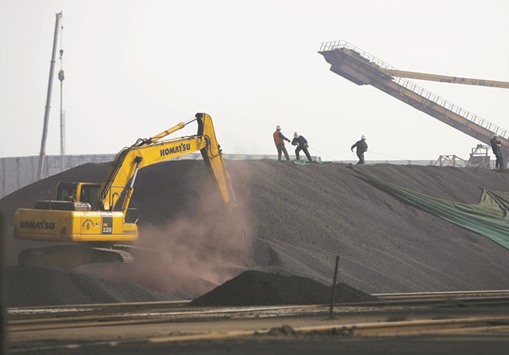Iron ore will probably collapse below $50 a metric tonne in the second half as global supply exceeds demand, according to Liberum Capital, which highlighted prospects for additional output coupled with lacklustre growth in consumption and record port stockpiles in China.
Prices will be back in the $40s as an extra 90mn tonnes of seaborne ore will hit the market in 2017, analyst Richard Knights said in an interview.
The increase comes at a time when holdings at ports in China are already at an all-time high, while steel consumption in the top user could be flat, he said.
“There’s a perception that demand is better than it actually is,” Knights said by phone from London. “The market – despite that apparent pickup in demand in the fourth quarter – is in significant oversupply, as evidenced by the amount of iron ore inventory. And supply is not decelerating, it’s accelerating this year.”
Iron ore took many investors by surprise in 2016 by surging more than 80% as stimulus in China supported steel output and consumption, even as low-cost mine supply expanded.
Plenty of analysts have now flagged the potential for a selloff this year, with Citigroup seeing a sharp correction and top forecaster RBC Capital Markets describing prices as unsustainable. With supply set to increase, Knights said that he’s “very bearish.”
“Particularly with prices where they are, there’s every incentive in the world to bring iron ore supply on,” said Knights, adding that there’s scope for the port stockpiles to expand further, before they slump. “It’s just as simple as supply exceeding demand, which obviously isn’t reflected in the price.”
Ore with 62% content in Qingdao rose 0.4% to $83.84 a dry tonne on Thursday, gaining for a third day to the highest level since October 2014, according to Metal Bulletin. The commodity is up about 6% this year after advancing in January to post a fourth monthly gain. The resurgence has boosted miners, including Rio Tinto Group, which this week reported its first profit gain since 2013, BHP Billiton and Fortescue Metals Group. Brazil’s Vale has seen its stock surge 25% this year as prices gain and it jacks up output from the giant new S11D mine.
The record bout of restocking in China has driven iron ore prices to “irrational” levels that are soon to correct, Gordon Johnson, an analyst at Axiom Capital Management, wrote in a note received Wednesday. Looking at days of inventory at Chinese mills and stockpiles at ports, both have never been this high, he said.
“Should steel capacity in China come offline as inventory is being destocked, we feel this would push iron ore prices forcefully lower,” Johnson said. Axiom sees iron ore at $57 in 2017 and $45 next year.
Not everyone is bearish. Prices may average $73 this year, according to JPMorgan Chase & Co, which sees them at $71 in the third quarter and $66 in the final three months. Last month, Singapore Exchange, which operates derivatives contracts that help to set global prices, said a survey of industry participants showed most expected rates to hold firm or gain.
Inventories at China’s ports climbed to 123.5mn tonnes last week, according to Shanghai Steelhome Information Technology Co.
The stockpiles are at about 75% of the ports’ holding capacity and are still growing fairly quickly, according to Knights. A further 20mn tons would bring them to about 90% of capacity, which could see a $20 to $30 drop in prices, he added.
“What will happen is the price will fall and also there will be an incentive for people to start drawing on those port stocks,” Knights said. “I’d expect that traders who hold that inventory would just start cutting the price to try and get rid of it, unless we’re bailed out by very, very strong demand in the first and second quarter, which is possible, but it’s not my base case.”

Labourers work on a pile of iron ore at a steel factory in Tangshan, China. Iron ore will probably collapse below $50 a metric tonne in the second half as global supply exceeds demand, according to Liberum Capital, which highlighted prospects for additional output coupled with lacklustre growth in consumption and record port stockpiles in China.

